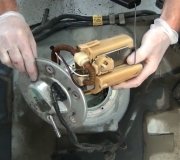Diagnostic fault codes never say to replace a sensor or other part referenced in that code. This is a perfect example. To get codes U1417 and U1418, you need to be getting signals from those wheel speed sensors, so they have to be working. When this happens, it is still possible for the sensor to be the cause of the code, but there's a much higher chance it is being caused by something else. In this case, the codes are not saying the speed signals have been lost. They're saying the signals don't make sense.
There's a diagnostic chart I can post for you, but the best place to start is with a couple of visual inspections. First check that all four tires are the same size. If one has a different outer circumference, it will spin at a different speed. The Anti-lock Brake Computer will see that, then assume it can't tell when one wheel is slowing down too quickly.
A less common cause of wrong speed signals is a cracked tone wheel. This can be hard to spot. It requires close inspection as you slowly rotate the outer CV joint / half shaft / wheel. This was more common on older models from the early to mid '90s. One clue was the yellow "ABS" light would be off each time the engine was started, then the code would set and the warning light would turn on after driving about a mile. The crack in the tone ring caused one extra pulse per wheel revolution. That can easily be attributed to going around a curve on the highway, but the computer rationalizes that won't occur for over a mile. The front and rear have different numbers of teeth on the tone rings. One used to have 47 teeth, and the other had 57 teeth. That isn't important as long as no additional pulse is being developed by a crack in the tone ring.
You can also try spinning the tone rings by hand, but that is not conclusive. If you are able to spin one, it is most likely cracked, however, they crack from water getting under them and freezing, and that water causes rust that can make a cracked ring feel tight.
To address the speedometer, "resetting" computers is not the answer. I have a suspicion there's something else going on, meaning he reset the gauge. It is not uncommon for gauge needles to spike under just the right conditions and get stuck on the wrong side of the stop peg near "0" on the gauge. Most commonly this occurs when reconnecting the battery that was disconnected for some other service. For a long time, gauges are no longer electric or thermal units attached to a pointer. Instead, they are "stepper" motors with the pointers attached to their armatures. Unlike regular motors with a spinning armature and brushes, stepper motors use four electromagnetic coils that are pulsed with varying voltages and polarities to place the armature in a specific position. The pointers are not spring-loaded to return to their lowest position. Instead, when the ignition switch is turned off, the instrument cluster pulses all the gauges to go to their lowest position in preparation for the next restart. If a gauge should get a voltage spike that sends it over halfway, the next time the ignition switch is turned on, it gets pulsed back to "0", and the armature looks for the shortest way there. In this case it is clockwise. That's when it will get stuck on the wrong side of the stop peg near "0".
There's three ways to get the pointer back on the correct side of that peg. The most difficult, by far, is to remove the bezel over the cluster and push the needle counterclockwise back to "0". Only do that if nothing else works. The faster method is to do a gauge test with a scanner. That will run all of them up to 1/4, then 1/2, then 3/4, then max, and finally back to "0". Once pulsed to "max", the stuck gauge will follow the others back to "0".
The easiest way to reset the gauge, in this case, is to simply drive fast enough so the instrument cluster wants to position the pointer over halfway. Once the shortest way to that speed is counterclockwise, the pointer will go there, then continue to work normally. In my Caravan, straight across from "0" appears to be 92 mph. If the pointer were to get stuck behind the stop peg, it would sit there until I drove 93 mph, at which time the shortest way to that speed would be counterclockwise. From there, it would come back down normally as the vehicle slows down.
I've seen this happen more often to tachometers, but not the other gauges. "5400" rpm is straight across from "0" on mine. I don't normally do this, but momentarily raising engine speed higher than 5400 rpm would make the pointer reset to the correct side of the stop peg.
Here's the diagnostic chart for code U1412. The charts for the other two codes are very similar. On older models, a "data buss" is a pair of wires the computers talk back and forth to each other on. On models as new as yours, there can be up to four data busses. The chart on the first page simply shows all the computers that are on Buss "C". That is a relatively low speed buss as the data has little importance to instantaneous decisions, like it is with air bags.
Images (Click to make bigger)
Monday, December 9th, 2024 AT 1:21 PM





